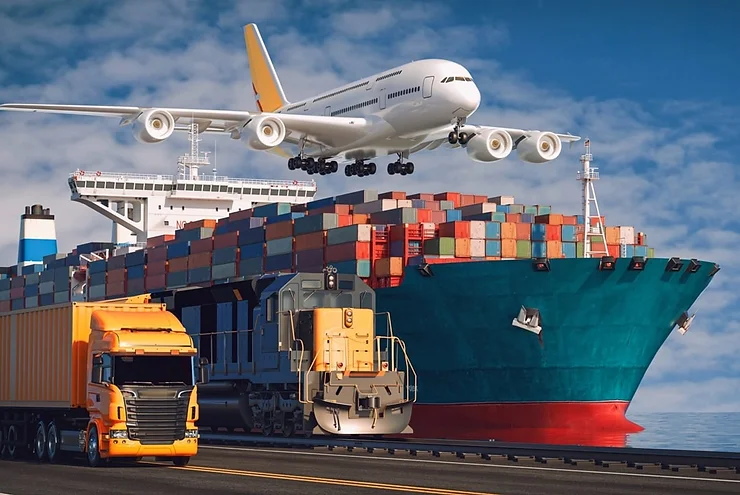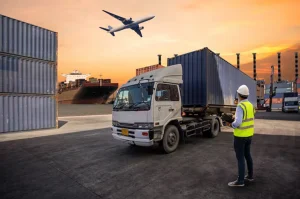Multimodal freight transportation is a logistics strategy that involves the use of multiple modes of transportation to move goods from one location to another. It combines various transportation modes, such as trucks, trains, ships, and planes, to optimize the movement of cargo, improve efficiency, reduce costs, and enhance overall supply chain performance. Here’s everything you need to know about multimodal freight transportation:
1. Key Modes of Transportation:
-
Trucking: Trucks are often the first and last mile of transportation and are essential for delivering goods to and from ports, warehouses, and distribution centers.
-
Rail: Trains are an efficient option for long-distance, heavy, and bulk cargo transportation. They are particularly useful for connecting landlocked regions to ports.
-
Maritime: Ships are the primary mode for transporting goods across oceans and seas. Various types of vessels cater to different cargo types.
-
Air: Air freight is the fastest mode of transportation and is suitable for high-value, time-sensitive, and perishable goods. It’s commonly used for international trade.
2. Intermodal vs. Multimodal:
-
Intermodal Transportation: This involves the use of standardized containers that can seamlessly transfer between different modes of transportation, such as trucks, trains, and ships. The cargo stays in the same container throughout the journey.
-
Multimodal Transportation: This refers to using different modes of transport but does not necessarily involve the same container. Cargo may need to be transferred from one mode to another during the journey.
3. Third-Party Logistics Providers (3PLs):
-
Many companies rely on 3PLs to manage their multimodal transportation needs. These companies have expertise in coordinating and optimizing the transportation of goods across various modes.
4. Technology and Tracking:
-
Advanced technology, such as GPS tracking, RFID, and transportation management systems (TMS), plays a crucial role in monitoring and optimizing the movement of goods in multimodal transportation.
In summary, multimodal freight transportation is a versatile and efficient approach to moving goods across various distances, offering cost savings, reliability, and environmental benefits. Its success relies on effective coordination, technology, and partnerships with transportation experts and providers.
Pros & Cons
Multimodal freight transportation offers several advantages and disadvantages for shippers and logistics providers. Here’s an overview of the pros and cons:
Pros of Multimodal Freight Transportation:
1. Cost Efficiency:
-
Cost Optimization: Multimodal transportation allows shippers to choose the most cost-effective mode for different segments of a shipment, reducing overall transportation expenses.
-
Economies of Scale: Utilizing various modes can lead to better utilization of infrastructure and equipment, potentially lowering costs.
2. Reliability:
-
Risk Mitigation: Using multiple modes reduces the risk of supply chain disruptions due to factors like weather, labor strikes, or capacity constraints in a single mode.
-
Enhanced Service Levels: Shippers can improve delivery reliability by choosing modes that align with their specific service requirements.
3. Capacity Management:
-
Efficient Resource Allocation: The ability to allocate capacity where it’s needed most can reduce bottlenecks and improve overall supply chain performance.
4. Global Reach:
-
International Trade: Multimodal transportation facilitates international trade by connecting landlocked regions to ports and enabling the movement of goods across continents.
5. Technology Integration:
-
Real-Time Tracking: Advanced technology and logistics solutions enable real-time tracking of shipments across different modes, improving visibility and supply chain management.
Cons of Multimodal Freight Transportation:
1. Complexity:
-
Coordination Challenges: Coordinating multiple modes, transfer points, and documentation requirements can be complex and prone to errors.
-
Scheduling Issues: Managing schedules and ensuring seamless transfers can be logistically demanding.
2. Regulations:
-
Compliance Burden: Different transportation modes often have distinct regulations, compliance requirements, and safety standards, necessitating careful attention to detail.
-
Customs and Documentation: International shipments involving multiple modes may require complex customs procedures and documentation.
3. Infrastructure Dependency:
-
Infrastructure Gaps: Adequate infrastructure, including intermodal terminals, roads, rail lines, and ports, is essential for efficient multimodal transportation. Inadequate infrastructure can be a barrier.
4. Transshipment Costs:
-
Handling Costs: Transferring cargo between modes can incur additional handling and storage costs.
-
Time Delays: Transshipment can introduce time delays, impacting delivery schedules.
5. Risk of Damage or Loss:
-
Cargo Handling: Each transfer point presents the risk of cargo damage, loss, or theft during the multimodal journey.
-
Insurance Considerations: Shippers may need to purchase additional insurance coverage to mitigate these risks.
6. Limited Applicability:
-
Not Suitable for All Cargo: Multimodal transportation may not be suitable for all types of cargo, particularly those with unique handling requirements or strict time constraints.
Selecting the transportation mode
Selecting the appropriate modes of transportation in multimodal freight transportation is a critical decision that can impact cost, efficiency, and overall supply chain performance. The choice of transport modes should be based on several factors, including the nature of the cargo, distance, time sensitivity and cost considerations. Here’s a guide to help you make informed transport selection decisions:
1. Nature of Cargo:
-
Bulk vs. Non-Bulk: Bulk goods like minerals, grains, and liquids are often best transported by rail, sea, or pipelines, while non-bulk goods can be transported by various modes.
-
Fragility and Sensitivity: Delicate or perishable goods may require air transport for speed and temperature control, while durable, non-perishable goods can use slower, more cost-effective modes like sea or rail.
2. Distance:
-
Short-Distance: Trucks are typically the go-to choice for short-haul transportation, especially for the first and last miles.
-
Long-Distance: Rail and sea transport are cost-effective for long-distance shipping, especially for bulk cargo. Air transport is suitable for extremely long distances when time is critical.
3. Time Sensitivity:
-
Time-Critical: Air freight is the fastest option for time-sensitive shipments. Trucks can also be used for shorter distances when speed is essential.
-
Flexible Timing: Rail and sea transport may take longer but offer cost advantages and can be used for less time-sensitive cargo.
4. Cost Considerations:
-
Cost-Efficiency: Consider the overall cost of transportation, including fuel, labor, maintenance, and fees. Select the mode that offers the best balance of cost and service.
-
Economies of Scale: High-volume cargo may benefit from rail or sea transport due to economies of scale.
5. Infrastructure and Accessibility:
-
Infrastructure Availability: Ensure that the necessary infrastructure, such as ports, rail lines, and intermodal terminals, is available and accessible for the selected modes.
-
Accessibility to Destinations: Consider whether the chosen modes can deliver cargo to the final destination, taking into account the entire supply chain.
6. Regulatory Compliance:
-
Regulatory Requirements: Different modes may have varying regulatory requirements, such as weight limits, hazardous material handling, and customs procedures. Ensure compliance with all relevant regulations.
7. Reliability and Risk Mitigation:
-
Reliability: Assess the reliability of each mode, taking into account factors like weather-related disruptions, labor strikes, and infrastructure reliability.
-
Risk Mitigation: Use multiple modes strategically to reduce the risk of disruptions. For example, sea and rail transport can be more resilient to weather-related issues than trucking.
8. Intermodal vs. Multimodal:
-
Intermodal: Consider whether using standardized containers and intermodal transportation is feasible and beneficial for your supply chain. Intermodal transportation simplifies mode transitions.
9. Customer and Market Requirements:
-
Customer Expectations: Align your choice of transportation modes with your customers’ expectations regarding delivery times and service levels.
-
Market Dynamics: Consider competitive pressures and market conditions that may affect your choice of transportation.
10. Cost-Benefit Analysis:
-
Conduct a thorough cost-benefit analysis for each transportation mode, considering all relevant factors such as transit time, costs, and risk mitigation.
Multimodal freight transportation involves combining different modes of transportation to move goods efficiently.
Here are some common types of multimodal transport modes:
1. Sea-Rail Combined Transportation:
-
This mode combines sea and rail transport. It is often used for cargo that needs to be moved from a seaport to an inland destination. Goods are initially transported by sea, and then containers or cargo are transferred to trains for further transportation.
2. Air-Rail Combined Transportation:
-
This mode combines air and rail transport. It is suitable for situations where air transportation is needed for long-distance or international travel, and then rail transport is used for the final leg of the journey to reach the destination.
3. Sea-Air-Rail Combined Transportation:
-
This mode combines sea, air, and rail transport. It’s a comprehensive approach often employed for international shipments. Cargo is initially transported by sea, followed by air transport for long distances, and then rail transport for local distribution.
4. Road-Rail Combined Transportation:
-
This mode combines road and rail transport. It is frequently used when cargo needs to be moved between locations not directly accessible by rail. Trucks transport goods to or from rail terminals for efficient long-distance travel.
5. Air-Road Combined Transportation:
-
This mode combines air and road transport. It is used when goods are transported by air for speed and efficiency and then transferred to trucks for the final delivery to the recipient.
6. Sea-Road Combined Transportation:
-
This mode combines sea and road transport. Cargo is transported by sea and then transferred to trucks for local delivery. It’s commonly used for distributing goods from a port to various destinations within a region.
Each of these multimodal transport modes offers advantages in terms of cost, speed, and efficiency, depending on the specific requirements of the shipment and the geographic locations involved. Selecting the appropriate combination of transport modes is crucial for optimizing supply chain logistics and meeting customer demands.
The Role of Toptrans in Multimodal Freight Transportation
Toptrans: Your Trusted Partner in Logistics
Meet Toptrans, your go-to partner for multimodal freight transportation. Learn about their 7 years of industry expertise and comprehensive service offerings.
A Diverse Fleet for Diverse Needs
Explore Toptrans’s diverse fleet and how they ensure safe and efficient transportation for various cargo types, including hazardous and military shipments.
Covering International Transport Directions
Uncover Toptrans’s expansive international network, connecting Georgia to the European Union, Turkey, the Central Asian countries, Ukraine, and China.








